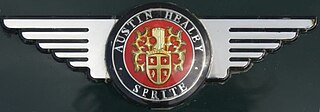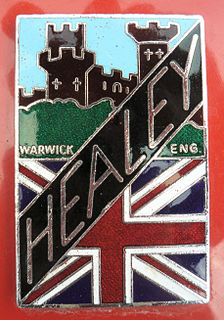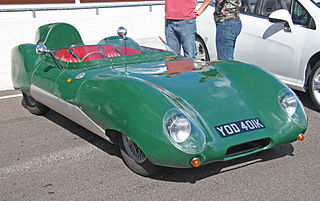
A kit car is an automobile available as a set of parts that a manufacturer sells and the buyer then assembles into a functioning car. Usually, many of the major mechanical systems such as the engine and transmission are sourced from donor vehicles or purchased new from other vendors. Kits vary in completeness, consisting of as little as a book of plans, or as much as a complete set with all components to assemble into a fully operational vehicle such as those from Caterham.

MG is a British automotive marque founded by Cecil Kimber in the 1920s, and M.G. Car Company Limited was the British sports car manufacturer that made the marque famous. Best known for its open two-seater sports cars, MG also produced saloons and coupés, with engines up to three litres in size and 3.5L in the case of the MGB GT V8. The marque is now owned by Chinese state-owned automaker SAIC Motor Corporation Limited.

The Austin Motor Company Limited was an English manufacturer of motor vehicles, founded in 1905 by Herbert Austin in Longbridge. In 1952 it was merged with Morris Motors Limited in the new holding company British Motor Corporation (BMC) Limited, keeping its separate identity. The marque Austin was used until 1987. The trademark is currently owned by the Chinese firm SAIC Motor, after being transferred from bankrupt subsidiary Nanjing Automotive which had acquired it with MG Rover Group in July 2005.

The Austin-Healey Sprite is a small open sports car produced in the United Kingdom from 1958 until 1971. The Sprite was announced to the press in Monte Carlo by the British Motor Corporation on 20 May 1958, two days after that year's Monaco Grand Prix. It was intended to be a low-cost model that "a chap could keep in his bike shed", yet be the successor to the sporting versions of the pre-war Austin Seven. The Sprite was designed by the Donald Healey Motor Company, with production being undertaken at the MG factory at Abingdon. It first went on sale at a price of £669, using a tuned version of the Austin A-Series engine and as many other components from existing cars as possible to keep costs down.
Donald Mitchell Healey CBE was a noted English car designer, rally driver and speed record holder.
Austin-Healey was a British sports car maker established in 1952 through a joint venture between the Austin division of the British Motor Corporation (BMC) and the Donald Healey Motor Company (Healey), a renowned automotive engineering and design firm. Leonard Lord represented BMC and Donald Healey his firm.

Donald Healey Motor Company Limited was a British car manufacturer.

The Austin-Healey 3000 is a British sports car built from 1959 until 1967. It is the best known of the "big Healey" models. The car's bodywork was made by Jensen Motors and the vehicles were assembled at BMC's MG Works in Abingdon, alongside the corporation's MG models.

Jensen Motors Limited was a British manufacturer of sports cars and commercial vehicles in West Bromwich, England. Brothers Alan and Richard Jensen gave the new name, Jensen Motors Limited, to the commercial body and sports car body making business of W J Smith & Sons Limited in 1934. It ceased trading in 1976. Though trading resumed in 1998, Jensen Motors Limited was dissolved in 2011.

Ashley were manufacturers of body shells and chassis for specials from 1955 to 1962. They also offered a range of products for special builds: radiators, header tanks, lighting sets, steel tubing, sheet aluminium, various suspension parts, water pumps, tires, tubes and wheels. The company also made bonnets and hardtops for other mass-produced sports cars, including the Austin-Healey Sprite and Jaguar E-Type.

The Mini Moke is a small, front-wheel-drive utility and recreational convertible, conceived and manufactured as a lightweight military vehicle by British Motor Corporation (BMC), and subsequently marketed for civilian use under the Austin, Morris, Leyland, and Moke brands. The name "Mini Moke" combines Mini with Moke, an archaic term for "mule".

The Austin-Healey 100 is a sports car that was built by Austin-Healey from 1953 until 1956.

The MG Midget is a small two-seater sports car produced by MG from 1961 to 1979. It revived a name that had been used on earlier models such as the MG M-type, MG D-type, MG J-type and MG T-type.

The Jensen-Healey is a British two-seater convertible sports car, produced by Jensen Motors Ltd. in West Bromwich, England from 1972 until 1976.

The Westfield XI is a British sports car and kit car based on the Lotus Eleven.
Geoffrey Carroll Healey was a British automotive engineer.

The GTM Coupé is a Mini based kit car dating back to 1967. GTM is an initialism for "Grand Touring Mini". The car was first shown at the 1967 Racing Car Show and soon afterwards went into production by the Cox brothers from their garage in Hazel Grove, Stockport as the Cox GTM. In 1969 the rights to the design and manufacturing were bought by Howard Heerey and the Cox part of the name was dropped. His father's company Midland Garage took over manufacture of the GTM. In April 1980 ownership changed again to GTM Engineering, who upgraded and continued to manufacture the Coupé until 1995.

The Austin-Healey Sebring Sprite is a small sports car that was produced by the Donald Healey Motor Company at its Cape Works in Warwick, the Healey's Speed Equipment Division in Grosvenor Street, London and subsequently by John Sprinzel Ltd from their well-known premises in Lancaster Mews. A modified version of the production Austin-Healey Sprite, it was recognized by the governing body of motorsport, the Fédération Internationale de l'Automobile, as a separate model in its own right, featuring Girling disc brakes as well as specified engine and chassis improvements. After its homologation (motorsport) on 17 September 1960, FIA regulations permitted the use of 'special bodies' and a small number of Sebring Sprites were subsequently fitted with coupé bodywork in aluminium alloy and glassfibre, the most strikingly attractive examples being those devised by well-known race and rally driver John Sprinzel, who had won the 1959 RAC British Rally Championship. Sprinzel commissioned the coachbuilders Williams & Pritchard, renowned for their racing and prototype work, to produce the bodies. These are usually said to have numbered six, but eight are known to have been made. Further Sprites received similar alloy bodywork from Alec Goldie and Fred Faulkner of the firm Robert Peel Sheet Metal Works. The name 'Sebring Sprite' would become a generic term for any Sprite with disc brakes, and later for any Sprite with coupé or fastback bodywork.
The Sprite Car Club of Australia is a club founded in 1960 for owners and enthusiasts of Austin-Healey Sprites and MG Midget cars. It was established by seven enthusiasts at a BMC car dealership in Sydney, for owners of Austin-Healey Sprite Bugeyes also known as Frogeye which started assembly in 1958 at Abingdon, Oxfordshire, England. Later from 1959, Sprites were shipped to Australia completely knocked down Complete knock down kit form to be assembled at Pressed Metal Corporation, at Enfield, New South Wales in Sydney. The range of models assembled in Australia included the Mk 1, 2, 2A, 3, 3A Sprites, and the Mk3 Midget.















